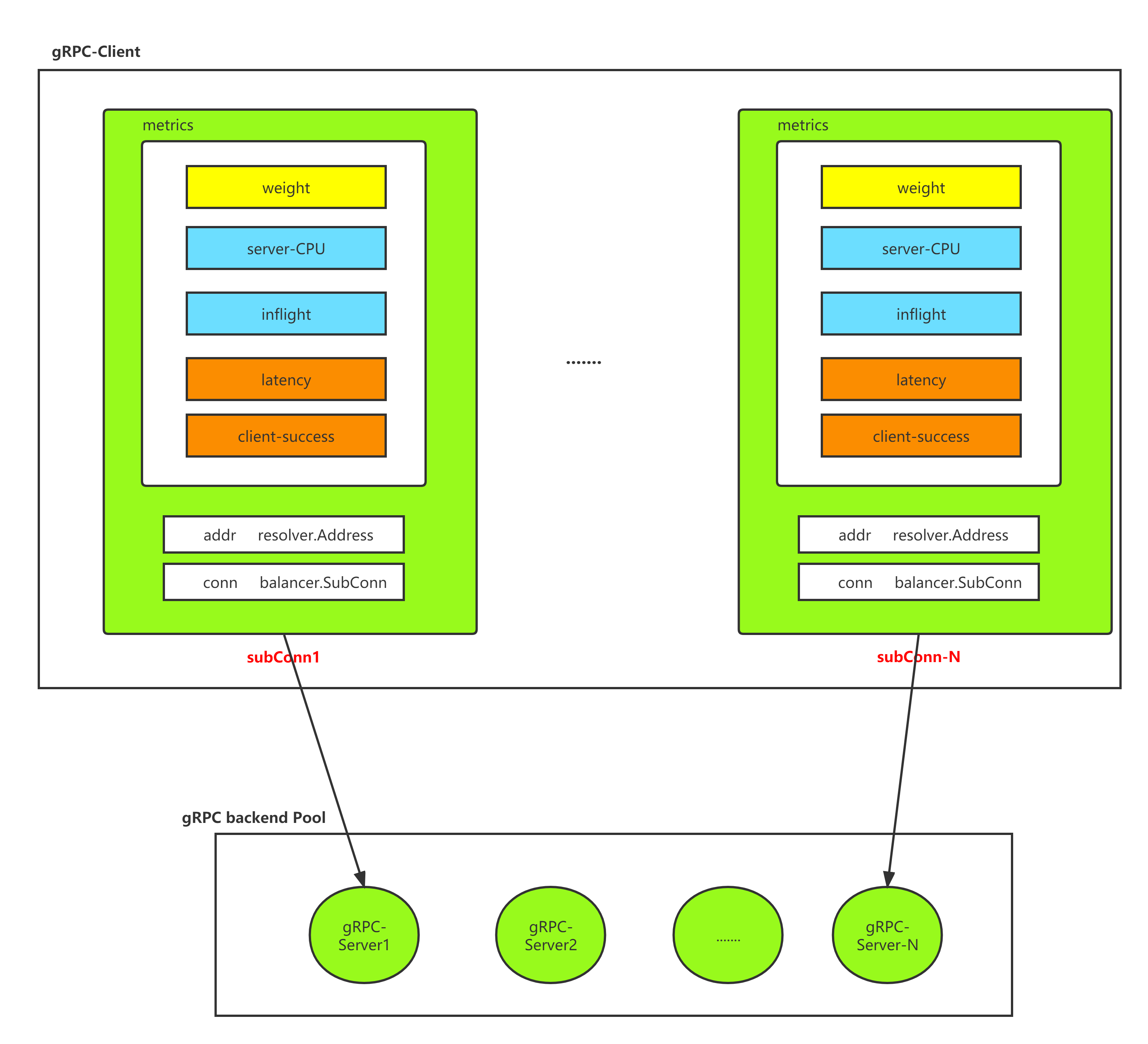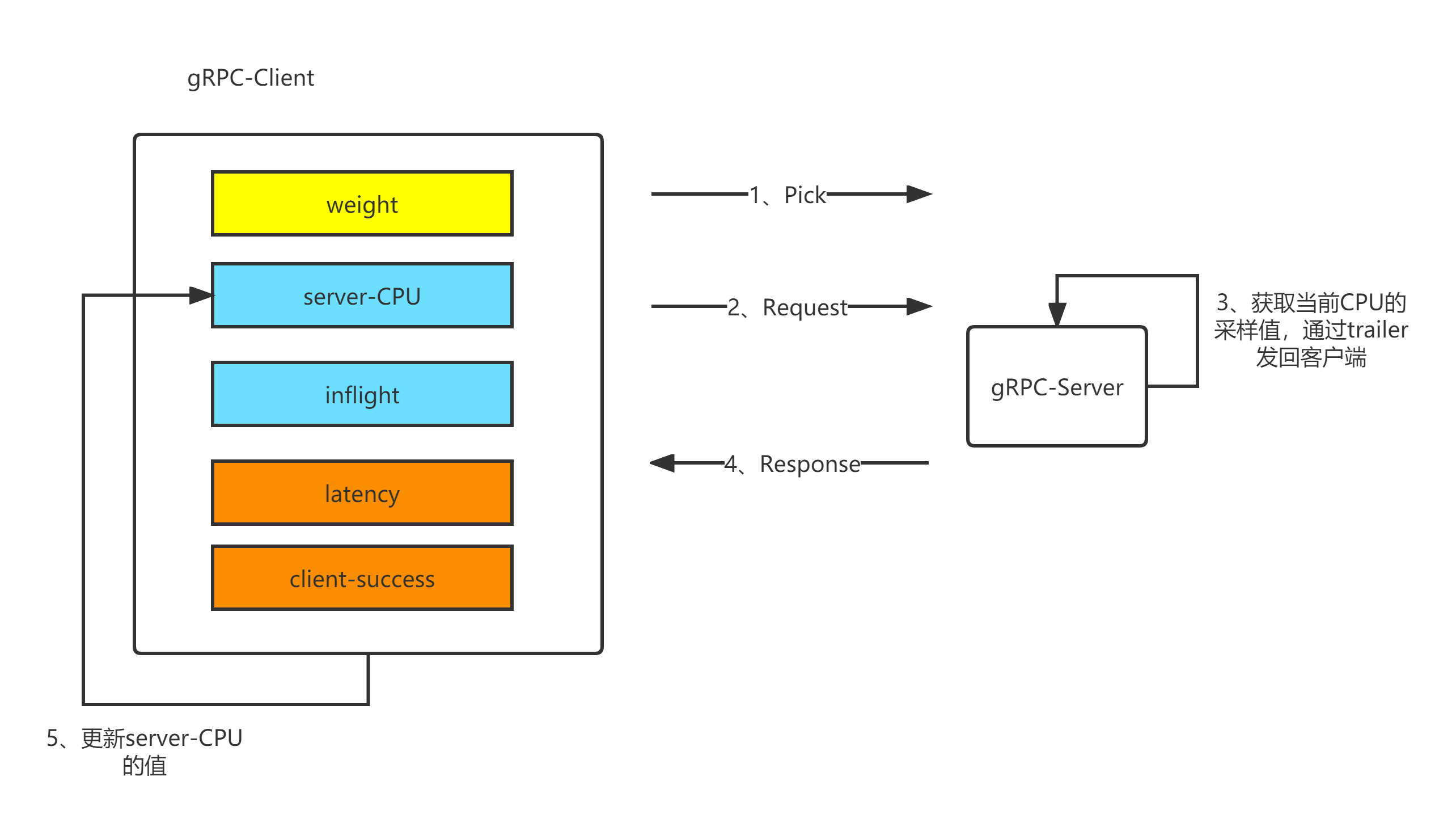0x00 前言
Warden 框架默认实现了两种负载均衡算法:
- WRR:Weight Round Robin(Dynamic)
- P2C:Power of Two Choice
之前的文章Kratos源码分析:分析 Kratos 中的 Dynamic-Wrr 负载均衡算法的实现,简单分析了WRR算法的实现思路及解决的场景。那么WRR算法存在哪些问题呢?
从B站的实践经验来看,动态感知的 WRR 算法,利用每次 RPC 请求返回的 Response 夹带 CPU 使用率,尽可能感知到服务负载,并且每隔一段时间整体调整一次节点的权重分数,虽然解决了原生WRR的权重固定的问题,但是存在羊群效应问题:“发现其实是信息滞后和分布式带来的羊群效应”,即
就是WRR版本的负载均衡算法虽然会自动刷新权重值,但是在刷新时无法做到完全的实时,再快也不可能超过一个 RTT,都会存在一些信息延迟差。当后台资源比较稀缺时,遇到网络抖动时,就可能会把该节点炸掉,但是在监控上面是感觉不到的,因为 CPU 已经被平均掉了。
从上面的描述看,问题的本质在于gRPC的负载均衡是在客户端实现的,客户端每次请求完获取到服务端CPU数据,可能会存在延迟,在延迟的空档期,大量请求涌入,导致某个后端Node接收大量请求,从而不可用的问题。
WRR (Weighted Round Robin)
该算法在加权轮询法基础上增加了动态调节权重值,用户可以在为每一个节点先配置一个初始的权重分,之后算法会根据节点 cpu、延迟、服务端错误率、客户端错误率动态打分,在将打分乘用户自定义的初始权重分得到最后的权重值。
0x01 P2C 算法介绍
Power of Two Choices (P2C,两次随机选择) 负载均衡算法,主要用于为每个 RPC 请求返回一个 Server 节点以供调用,该算法策略出自论文 《The Power of Two Random Choices: A Survey of Techniques and Results》 ,主要思路如下:
- 从可用后端节点列表中做
2次选择操作(随机算法 or 依据一定策略来选择),得到节点nodeA、nodeB - 比较
nodeA、nodeB两个节点,选出负载最低(一般是正在处理的连接数 / 请求数最少)的节点作为被选中的节点
伪代码如下:
nodeA = random_choice(nodes)
nodeB = random_choice(nodes)
best = least_connection_choice([nodeA, nodeB])
此外,有几篇详细的算法实践的文章推荐阅读下:
- 来自 HAPROXY 的 Test Driving Power of Two Random Choices Load Balancing
- The power of two random choices
0x02 思考
既然 gRPC 的负载均衡的算法是在客户端实现的,那么如何设计一款好的负载均衡算法?
- 默认情况下(HTTP2)每个 gRPC-Client 都维护这与 N 个后端 gRPC-Server 的长连接
N个后端服务节点,初始化有一个权重值,每次调用 RPC 方法前,先根据算法打分,权重高的后端被选择用于本次 RPC 过程,那么如何调整权重值?有几个维度需要关心的- gRPC-Client 实时根据当前的后端服务端节点的负载动态调整权重:考虑服务端的 CPU(区间采样,如何消除毛刺?)、内存信息
- gRPC-Client 本身记录当前并发的(积压)RPC 请求
- gRPC-Client 每次完成 RPC 请求,记录到这个后端服务节点的 latency(延迟)
- gRPC-Client 累计的请求失败率、服务端失败率(不同视角)
- 考虑 RPC 失败后的 retry 重试逻辑
- 考虑客户端 gRPC-Client 在收到服务端 gRPC-Server 的指标信息的滞后(客户端接收服务端指标数据可能有延迟的场景)
这些点和疑问,在阅读 Warden 负载均衡的算法时,都得到了解答。
0x03 P2C 实现
官方的文档 上给出了实现的一些关键细节,先列举下,然后再结合代码做下分析:
P2C (Pick of two choices) 算法描述
本算法通过随机选择两个 node 选择优胜者来避免羊群效应,并通过 EWMA 尽量获取服务端的实时状态。
针对 服务端 的指标:
服务端获取最近 500ms 内的 CPU 使用率(针对容器场景:需要将 cgroup 设置的限制考虑进去,并除于 CPU 核心数),并将 CPU 使用率乘与 1000 后塞入每次 gRPC 请求中的的 Trailer 中夹带返回
针对 客户端 的指标,主要参数如下:
- server_cpu:通过每次请求中服务端塞在 trailer 中的 cpu_usage 拿到服务端最近 500ms 内的 cpu 使用率
- inflight:当前客户端正在发送并等待 response 的请求数(pending request)
- latency: 加权移动平均算法计算出的接口延迟
- client_success: 加权移动平均算法计算出的请求成功率(只记录 gRPC 内部错误,比如 context deadline)
权重计算
计算权重的公式如下:
\[\frac{success*metaWeight}{cpu*\sqrt{lag}*(inflight+1)}\]这个公式的含义很直观,对权重有积极影响的因子,如成功率,初始权重等,位于分子;对权重有消极影响的因子,如cpu负载(过高)、lag延迟(过大)、以及积压的请求数inflight,放在分母的位置。(为了防止除法溢出,inflight做了加1处理)
EWMA 算法简介
P2C 代码实现中大量使用了 EWMA 算法(指数加权移动平均算法),此算法,是对观察值分别给予不同的权数,按不同权数求得移动平均值,并以最后的移动平均值为基础,确定预测值的方法。采用加权移动平均法,是因为观察期的近期观察值对预测值有较大影响,它更能反映近期变化的趋势。
- 指数移动加权平均法,是指各数值的加权系数随时间呈指数式递减,越靠近当前时刻的数值加权系数就越大
- 指数移动加权平均较传统的平均法来说,一是不需要保存过去所有的数值;二是计算量显著减小
感兴趣的可以阅读这篇文章:指数加权移动平均法(EWMA)
EWMA 算法的修正(预测)公式是:
\[Z_i=w*X_{cur} + (1-w)*Z_{i-1}\]其中,在 P2C 算法中,w 系数按照下面的规则获取:
w := math.Exp(float64(-td) / float64(tau))
预测的方法是,每隔一段时间进行一次采样,每次采样完成之后,就对预测值进行一次修正,这种方法的特点是近期的采样值对预测值的影响大,远期的影响较小。从算法应用场景可知,和 P2C 算法计算场景比较类似,这里针对 p2c.subConn 结构使用 EWMA 算法,只需要保存上一次计算拿到的结果即可。
0x04 代码分析
全局变量:
const (
// The mean lifetime of `cost`, it reaches its half-life after Tau*ln(2).
tau = int64(time.Millisecond * 600)
// if statistic not collected,we add a big penalty to endpoint
penalty = uint64(1000 * time.Millisecond * 250)
forceGap = int64(time.Second * 3)
)
p2c.subConn,封装了 balancer.SubConn,代表了 Client 到 Server 的一条长连接,封装了核心属性(计算权重需要):
其中重要的字段说明如下(牢记一个 subConn 代表了客户端到某个服务端 Node 的唯一属性):
meta:在服务发现(Etcd)中设置的 Node 的初始值lag:请求延迟(用于与下次实现加权计算)success:使用加权算法拿到的客户端 RPC 调用成功率inflight:当前正在处理的请求数svrCPU:保存了服务端返回的最近一段时间的 CPU 使用率stamp:保存上次计算权重的时间戳(Nano)
gRPC客户端的连接池如下图所示:

type subConn struct {
// metadata
conn balancer.SubConn
addr resolver.Address
meta wmd.MD
//client statistic data
lag uint64
success uint64
inflight int64
// server statistic data
svrCPU uint64
//last collected timestamp
stamp int64
//last pick timestamp
pick int64
// request number in a period time
reqs int64
}
p2c.subConn 实现的方法:
valid:health:获取当前长连接中存储的成功率sc.success的值load:cost:
func (sc *subConn) valid() bool {
return sc.health()> 500 && atomic.LoadUint64(&sc.svrCPU) < 900
}
func (sc *subConn) health() uint64 {
return atomic.LoadUint64(&sc.success)
}
func (sc *subConn) load() uint64 {
lag := uint64(math.Sqrt(float64(atomic.LoadUint64(&sc.lag))) + 1)
load := atomic.LoadUint64(&sc.svrCPU) * lag * uint64(atomic.LoadInt64(&sc.inflight))
if load == 0 {
// penalty 是初始化没有数据时的惩罚值,默认为 1e9 * 250
load = penalty
}
return load
}
func (sc *subConn) cost() uint64 {
load := atomic.LoadUint64(&sc.svrCPU) * atomic.LoadUint64(&sc.lag) * uint64(atomic.LoadInt64(&sc.inflight))
if load == 0 {
// penalty 是初始化没有数据时的惩罚值,默认为 1e9 * 250
load = penalty
}
return load
}
指标的计算详解-inflight

LB 核心逻辑 – Builder
p2cPickerBuilder.Build 在每次后端节点有增减的情况下调用,初始化时会调用一次,readySCs 保存了后端服务器的基础信息,从代码实现上看,也是做了对节点的初始化工作:
当后端有删减时,也会强制把已存在的后端节点进行初始化(感觉这一点,gRPC 不是很友好):
这里后端的初始化数据为
svrCPU: 500lag: 0success:1000inflight: 1
type p2cPickerBuilder struct{}
func (*p2cPickerBuilder) Build(readySCs map[resolver.Address]balancer.SubConn) balancer.Picker {
p := &p2cPicker{
colors: make(map[string]*p2cPicker),
// 初始化 rand 种子
r: rand.New(rand.NewSource(time.Now().UnixNano())),
}
// 初始化后端的权重数据
for addr, sc := range readySCs {
fmt.Println("[p2cPickerBuilder.Builder]init:",addr,sc)
meta, ok := addr.Metadata.(wmd.MD)
if !ok {
meta = wmd.MD{
Weight: 10,
}
}
subc := &subConn{
conn: sc,
addr: addr,
meta: meta,
svrCPU: 500,
lag: 0,
success: 1000,
inflight: 1,
}
if meta.Color == "" {
p.subConns = append(p.subConns, subc)
continue
}
// if color not empty, use color picker
// 如果服务端定义了 color 筛选,则启动 color 的选择逻辑(测试时没用)
cp, ok := p.colors[meta.Color]
if !ok {
cp = &p2cPicker{r: rand.New(rand.NewSource(time.Now().UnixNano()))}
p.colors[meta.Color] = cp
}
cp.subConns = append(cp.subConns, subc)
}
return p
}
LB 核心逻辑 - Picker
p2c.Picker 实现了负载均衡的选择逻辑:
Pick:主方法入口- 先调用
prePick,选择两个随机的 node - 最后从上一步的 node 列表中选取一个合适的 node,返回其对应的
subConn,执行 RPC 请求 - 根据RPC请求结果及 node 回带的服务端 CPU 字段信息,更新本
subConn的核心因子信息stampsuccesslag
p2cPicker 结构:
type p2cPicker struct {
// subConns is the snapshot of the weighted-roundrobin balancer when this picker was
// created. The slice is immutable. Each Get() will do a round robin
// selection from it and return the selected SubConn.
subConns []*subConn // 保存所有的后端
colors map[string]*p2cPicker
logTs int64 //
r *rand.Rand
lk sync.Mutex
}
接下来着重分析下 pick 和 prePick 方法:
prePick 方法,实现了随机选择的逻辑,总循环 3 次,随机从 subConns []*subConn 中选择两个节点 nodeB 和 nodeA,如果满足 node.valid() 的要求,直接返回,不满足的话,返回最后一次的选择的两个节点:
注意返回值中的 nodeA 和 nodeB 都是 subConn 结构。
// choose two distinct nodes
func (p *p2cPicker) prePick() (nodeA *subConn, nodeB *subConn) {
for i := 0; i < 3; i++ {
p.lk.Lock()
a := p.r.Intn(len(p.subConns))
b := p.r.Intn(len(p.subConns) - 1)
p.lk.Unlock()
if b >= a {
b = b + 1
}
nodeA, nodeB = p.subConns[a], p.subConns[b]
if nodeA.valid() || nodeB.valid() {
break
}
}
return
}
picker 的实现如下,重要部分已加了注释,需要关注的有如下几点信息:
DoneInfo()是在 RPC 方法执行完成后的回调,主要用于在 gRPC 的Trailer返回的pc对应的服务端 CPU 信息,根据此 CPU 信息,更新pc这个subConn的相关信息- 计算权重分数的方法,每次请求来时我们都会更新延迟,并且把之前获得的时间延迟进行权重的衰减,新获得的时间提高权重,这样就实现了滚动更新
func (p *p2cPicker) Pick(ctx context.Context, opts balancer.PickInfo) (balancer.SubConn, func(balancer.DoneInfo), error) {
// FIXME refactor to unify the color logic
color := nmd.String(ctx, nmd.Color)
if color == ""&& env.Color !="" {
color = env.Color
}
if color != "" {
if cp, ok := p.colors[color]; ok {
return cp.pick(ctx, opts)
}
}
return p.pick(ctx, opts)
}
func (p *p2cPicker) pick(ctx context.Context, opts balancer.PickInfo) (balancer.SubConn, func(balancer.DoneInfo), error) {
var pc, upc *subConn
start := time.Now().UnixNano()
if len(p.subConns) <= 0 {
return nil, nil, balancer.ErrNoSubConnAvailable
} else if len(p.subConns) == 1 {
// 只有 1 个节点,直接返回
pc = p.subConns[0]
} else {
nodeA, nodeB := p.prePick()
// meta.Weight 为服务发布者在 disocvery 中设置的权重
if nodeA.load()*nodeB.health()*nodeB.meta.Weight > nodeB.load()*nodeA.health()*nodeA.meta.Weight {
//pc 为本次算法选择的节点
pc, upc = nodeB, nodeA
} else {
pc, upc = nodeA, nodeB
}
// 如果选中的节点,在 forceGap 期间内没有被选中一次,那么强制一次
// 利用强制的机会,来触发成功率、延迟的衰减
// 原子锁 conn.pick 保证并发安全,放行一次
pick := atomic.LoadInt64(&upc.pick)
if start-pick > forceGap && atomic.CompareAndSwapInt64(&upc.pick, pick, start) {
pc = upc
}
}
// 节点未发生切换才更新 pick 时间
if pc != upc {
atomic.StoreInt64(&pc.pick, start)
}
atomic.AddInt64(&pc.inflight, 1)
atomic.AddInt64(&pc.reqs, 1)
// RPC 方法执行完成后,更新状态
return pc.conn, func(di balancer.DoneInfo) {
atomic.AddInt64(&pc.inflight, -1)
now := time.Now().UnixNano()
// get moving average ratio w
stamp := atomic.SwapInt64(&pc.stamp, now)
td := now - stamp
if td < 0 {
td = 0
}
w := math.Exp(float64(-td) / float64(tau))
lag := now - start
if lag < 0 {
lag = 0
}
oldLag := atomic.LoadUint64(&pc.lag)
if oldLag == 0 {
w = 0.0
}
lag = int64(float64(oldLag)*w + float64(lag)*(1.0-w))
atomic.StoreUint64(&pc.lag, uint64(lag))
success := uint64(1000) // error value ,if error set 1
if di.Err != nil {
if st, ok := status.FromError(di.Err); ok {
// only counter the local grpc error, ignore any business error
if st.Code() != codes.Unknown && st.Code() != codes.OK {
success = 0
}
}
}
oldSuc := atomic.LoadUint64(&pc.success)
success = uint64(float64(oldSuc)*w + float64(success)*(1.0-w))
atomic.StoreUint64(&pc.success, success)
// 从服务端的 Trailer 中拿到 CPU 的值
trailer := di.Trailer
if strs, ok := trailer[wmd.CPUUsage]; ok {
if cpu, err2 := strconv.ParseUint(strs[0], 10, 64); err2 == nil && cpu > 0 {
atomic.StoreUint64(&pc.svrCPU, cpu)
}
}
logTs := atomic.LoadInt64(&p.logTs)
if now-logTs > int64(time.Second*3) {
if atomic.CompareAndSwapInt64(&p.logTs, logTs, now) {
p.printStats()
}
}
}, nil
}
这里我们把 RPC 调用成功时的回调逻辑简单分析下:
start := time.Now().UnixNano()
...
return pc.conn, func(di balancer.DoneInfo) {
// 当前正在处理的请求数减 1,好理解
atomic.AddInt64(&pc.inflight, -1)
// 取当前的时间戳(Nano)
now := time.Now().UnixNano()
// get moving average ratio w
// 获取 && 设置上次测算的时间点,将 pc.stamp 的值更新为 now
stamp := atomic.SwapInt64(&pc.stamp, now)
// 获取时间间隔
td := now - stamp
if td < 0 {
td = 0
}
// 获取时间衰减系数
w := math.Exp(float64(-td) / float64(tau))
// 获得本次延迟数据 1(注意 start 是在 pick 开始计时的)
lag := now - start
if lag < 0 {
lag = 0
}
// 获取上次保存的延迟数据 2
oldLag := atomic.LoadUint64(&pc.lag)
if oldLag == 0 {
w = 0.0
}
// 延迟数据 1 与延迟数据 2,计算出平均延迟(EWMA)
lag = int64(float64(oldLag)*w + float64(lag)*(1.0-w))
// 保存本地计算出的延迟数据
atomic.StoreUint64(&pc.lag, uint64(lag))
success := uint64(1000) // error value ,if error set 1
if di.Err != nil {
if st, ok := status.FromError(di.Err); ok {
// only counter the local grpc error, ignore any business error
if st.Code() != codes.Unknown && st.Code() != codes.OK {
success = 0
}
}
}
oldSuc := atomic.LoadUint64(&pc.success)
success = uint64(float64(oldSuc)*w + float64(success)*(1.0-w))
atomic.StoreUint64(&pc.success, success)
// 从服务端的 Trailer 中拿到 CPU 的值
trailer := di.Trailer
if strs, ok := trailer[wmd.CPUUsage]; ok {
if cpu, err2 := strconv.ParseUint(strs[0], 10, 64); err2 == nil && cpu > 0 {
atomic.StoreUint64(&pc.svrCPU, cpu)
}
}
logTs := atomic.LoadInt64(&p.logTs)
if now-logTs > int64(time.Second*3) {
// 超过一个 3s 的周期,尝试打印当前状态
if atomic.CompareAndSwapInt64(&p.logTs, logTs, now) {
p.printStats()
}
}
}, nil
统计节点
//INFO 07/24-07:50:56.452 /root/delete/kratos-note/pkg/net/rpc/warden/balancer/p2c/p2c.go:292 p2c : [{addr:127.0.0.1:8081 score:783813.9288438039 cs:1000 lantency:2612717 cpu:789 inflight:1 reqs:1}]
// statistics is info for log
type statistic struct {
addr string
score float64
cs uint64
lantency uint64
cpu uint64
inflight int64
reqs int64
}
func (p *p2cPicker) printStats() {
if len(p.subConns) <= 0 {
return
}
stats := make([]statistic, 0, len(p.subConns))
for _, conn := range p.subConns {
var stat statistic
log.Info("p2c detail [OLD] info %s : %+v", p.subConns[index].addr.ServerName, conn)
stat.addr = conn.addr.Addr
stat.cpu = atomic.LoadUint64(&conn.svrCPU)
stat.cs = atomic.LoadUint64(&conn.success)
stat.inflight = atomic.LoadInt64(&conn.inflight)
stat.lantency = atomic.LoadUint64(&conn.lag)
stat.reqs = atomic.SwapInt64(&conn.reqs, 0)
load := conn.load()
if load != 0 {
stat.score = float64(stat.cs*conn.meta.Weight*1e8) / float64(load)
}
stats = append(stats, stat)
}
log.Info("p2c %s : %+v", p.subConns[0].addr.ServerName, stats)
for index,conn:=range p.subConns{
log.Info("p2c detail [NEW] info %s : %+v", p.subConns[index].addr.ServerName, conn)
}
}
0x05 测试
我们给关键路径加上日志,看下这里具体参数和值的变化过程,这样对算法能够有更为直观的理解,我们以 etcd 为注册服务,启动三个后端(单个单个启动),观察下数据的变化。